Unusual Things to do in Vienna: 9 Places the Guidebooks Won’t Take You

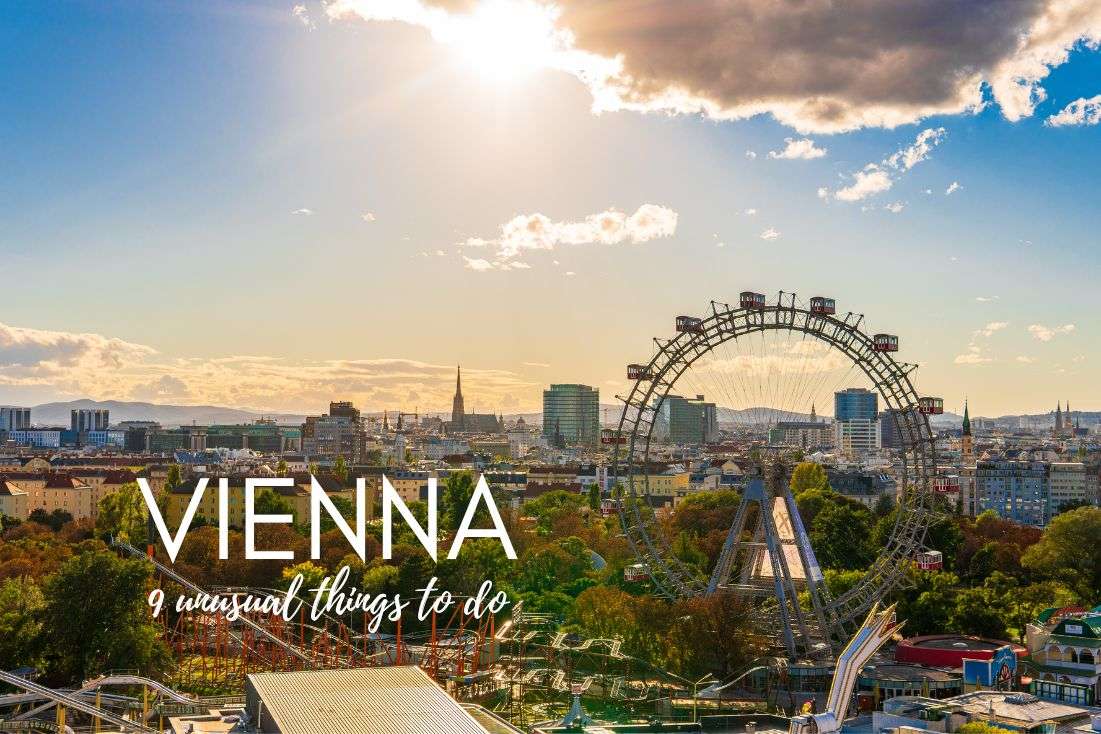
I get that you’re looking for some quirky or weird things to do in Vienna because, let’s be honest, the magnificent city of Vienna can be a bit of a bore. Though it’s known for its thriving art scene, opera houses, museums, and palaces, to me, it’s always been lacking in personality.
I mean, go ahead and look at Stephansdom and some of the other stately buildings in Vienna's city center. If you’re from another continent, you will probably ooh and aah a couple of times. But after a while, you might start wondering, “Now what?”.
Since Vienna isn’t very exciting at first glance—unless you’re a history and art buff, in which case, enjoy the museums—I’ve decided to spice it up with some unusual things to do in Vienna and squeeze some life into the old gal, all updated with 2025 prices and opening times
Read more about visiting Austria.

Here’s a quick summary of the weird stuff you can experience:
What are the best unique experiences in Vienna?
- Taste Sacher torte (Austrian chocolate cake) from the original 1832 recipe
- Explore the hidden parts of Stephen’s Cathedral
- Take a walk with Hitler on the Historical Hitler Walking Tour
- Uncover the art of deception at the Museum of Fake Art (Fälschermuseum)
- Stare at Vienna’s wackiest building: Hundertwasserhaus
- Meet the legendary Lipizzaner Stallions at Vienna’s Spanish Riding School
- Find the Giant Atlas Moth in the butterfly-filled jungle of the Schmetterlingshaus
- Face the beauty of death at the Josephinum Medical Museum
- Enter the twisted world of the Narrenturm (Fool’s Tower)
Vienna tourist map: Where to find the quirky things?
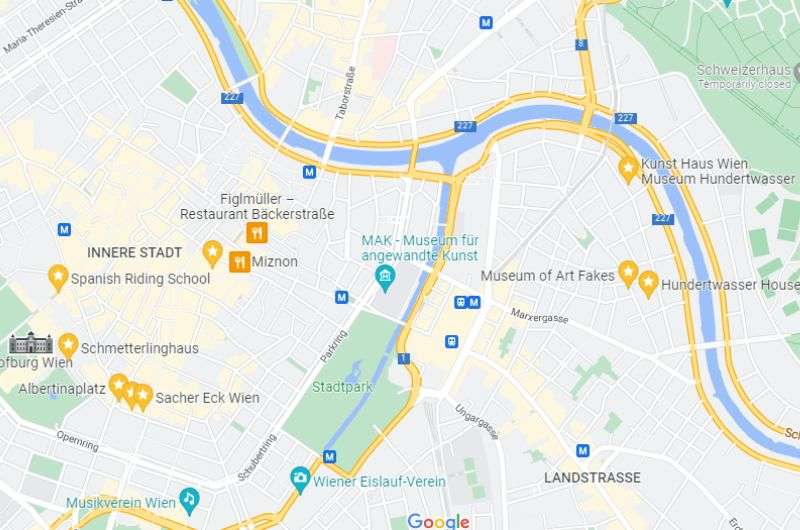
This is where the top unusual things to do are located. Tip: When booking your hotel, pick one that is close to everything, like Boutiquehotel Das Tyrol or Steigenberger Hotel Herrenhof
Is Vienna Worth Visiting? A UNESCO World Heritage Site

She is thinking about how happy she is not to be in Vienna, enjoying the Austrian mountains instead
I didn’t hold back in my intro, so this won’t come as a surprise. I’m not a huge fan of the city. It’s a snoozefest.
Update! I've decided to give Vienna yet another try, and she may be starting to grow on me. It's still a boring city compared to many others in Europe, but it's not horrible, and I'm not going to try to stop you from visiting. If you want to see what I did on my last visit, you can follow my 3-day Vienna itinerary.
Vienna has a rich history, museums, and stories waiting to be told. Just like any other European city. It’s Amsterdam without the canals and charm. It’s Prague with a big ego and no cute alleyways. It’s Berlin without its edge and Paris without the dirt... ok, maybe it’s not all bad. It is clean.
Exploring Vienna's local culture, particularly through activities like beer tastings and venturing away from tourist hotspots, can lead to unexpected discoveries.
There are, however, many other places in Austria that I do recommend you visit, like the gorgeous area around Zell am See. I’ve written a whole post summarizing the 11 best places to visit in Austria, or another one just on the top Austrian cities for those of you who hate nature. Here's my full 10-day Austria itinerary if you don't care to do any research and just want somebody to plan your trip for you.
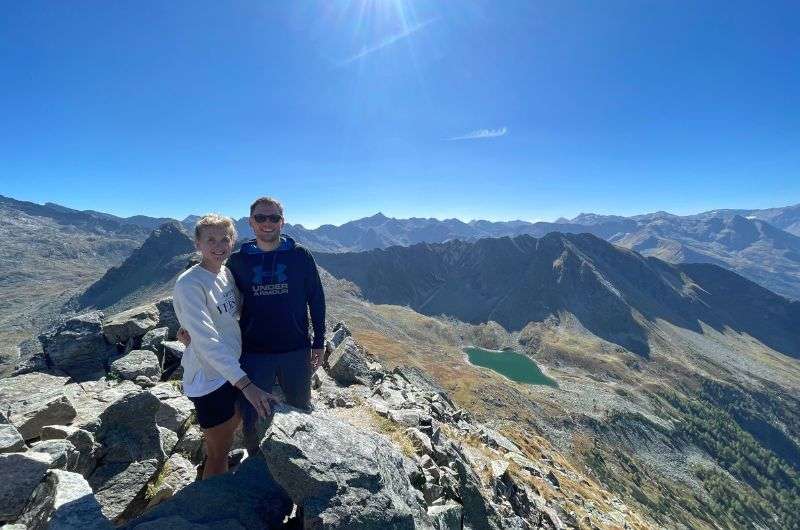
Taking Austria to new heights... While Vienna might still be growing on me, the Austrian Alps need no convincing—breathtaking views, crisp mountain air, and the perfect adventure @ Graukogel
My top tips for visiting Vienna
- Visit the roof of the Stephansdom. It’s tiled and colorful, and not even snow dares stay on it!
- Check out the strange architecture of Kunst Haus Wien. It’s a museum and photo gallery all in one.
- Visit the Austrian National Library, a notable historical and architectural landmark in Vienna.
- Don’t linger too long; Vienna is semi-boring! Head to the mountains instead—Austria’s nature is where the country truly shines
If you want to check Vienna out for yourself, go ahead and book a hotel. For your next stay in Vienna, I can recommend these two hotels: Boutiquehotel Das Tyrol for their fantastic location and good value.
Here are unusual things to do in Vienna that we think will make your stay a tad more interesting:
1. Indulge in the best Sachertorte in City Center
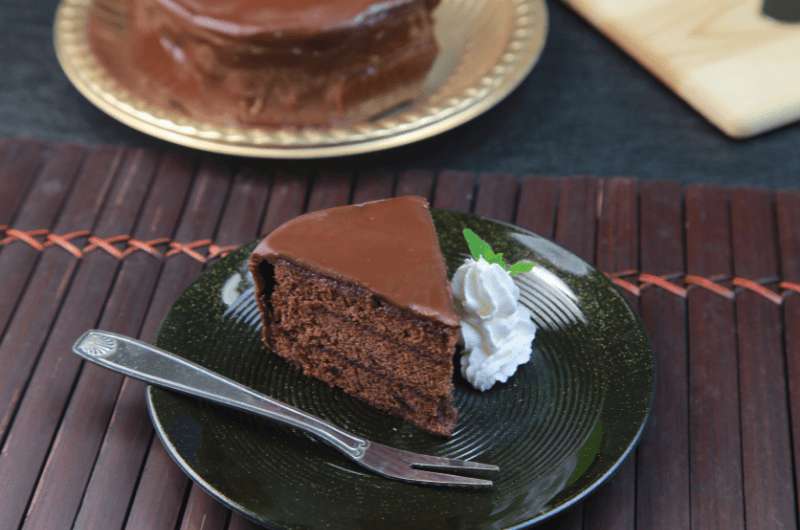
Yummy! Sacher
We haven't even started yet, and it's already time for dessert? Sure, why not?! Sachertorte is a Viennese classic dessert—a decadent chocolate cake with apricot jam in the middle. The home of Sachertorte is Café Sacher, part of Hotel Sacher Wien, which offers delicious cake from an original 1832 recipe. Go and try the famous Sacher cake at its original home. It sits across from the Vienna State Opera, so you can get a glimpse of that on the way, too.
Making reservations is strongly suggested and can be done online. They do keep plenty of tables open for casual visitors. Unfortunately, given the famous location, a very large number of casual visitors want to get in at all times of the day.
If you can't find a table at Café Sacher, all is not lost—head just a few steps down to the corner of the hotel to the Café Bel Étage. This two-story café is lavish and belongs to the Sacher Hotel, so no need to compromise on quality. Different chairs, same sacher. Once you get in, you’ll be seated on red velvet sofas under massive chandeliers that will make you feel as decadent as a sachertorte. Grab a coffee and a sacher and enjoy!
- Café Sacher, Philharmoniker Str. 4, open daily 8 am–10 pm
- Café Bel Étage, Kärntner Str. 38, open daily 8 am–9 pm
2. Explore the hidden parts of Stephen's Cathedral
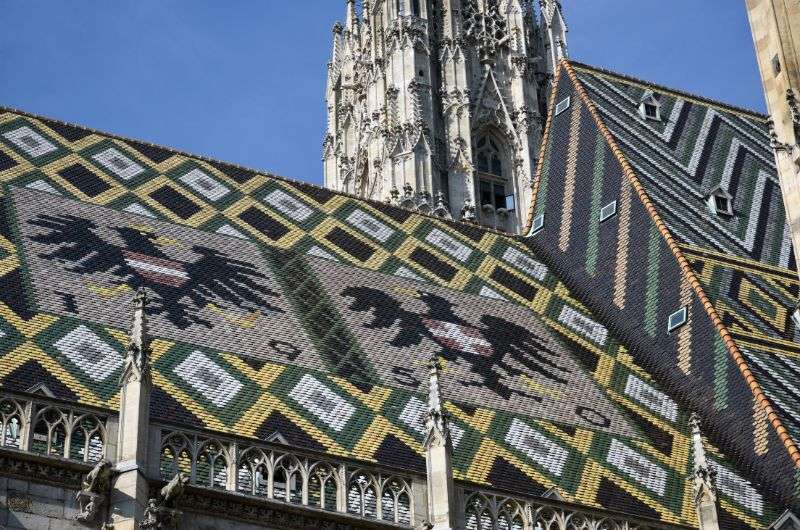
The mosaics on the roof of Stephen’s Cathedral
St. Stephen’s Cathedral, or Stephansdom, lies at the heart of Vienna and forms a central landmark. It’s the church you see in all the photos when you Google Vienna. From the City Center, it was super easy to find.
Parts of a 12th-century Romanesque church remain on the site. Inside, you’ll find many Gothic ornaments. Interesting, to say the least. Look for crying cherubs clutching skulls, giant sarcophagi, or statues of tortured saints.
Rooftop mosaics
But the roof is where the real party’s at! Not your regular boring church roof, the Stephansdom is topped by a fantastic display of colorful tiled art! Stephansdom is part of Vienna’s UNESCO-listed historic center, adding to its historical significance. Which is about the only church I really liked in Vienna. The massive eagles made out of mosaics represent the Austrian Empire on the south side, and on the north side, more eagles! This time, they represent the coat of arms of the City of Vienna and of the Republic of Austria.
Fun fact: The Stephansdom’s roof is sloped much more steeply than other churches, and thanks to this, it is rarely covered in snow. It stays vibrant all year round while other buildings are covered in a white blanket.
You can take a glance at the ornate roof from one of the towers. The views of the roof are better from the south tower, but there are only stairs leading up there. If you would rather not break a sweat, the north tower has an elevator and better views of the city, plus the largest bell in Austria, the famous Pummerin.
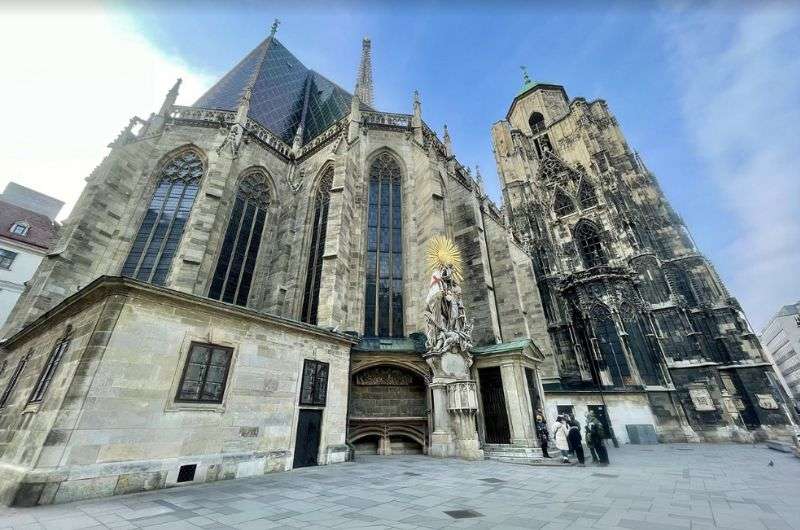
Stephansdom is an unmissable stop in Vienna and just about the only church that was memorable to me
Catacombs
Beneath the cathedral lie the catacombs, home to the bones of over 11,000 people. The older half is a series of connected crypts below the cathedral. In the catacombs, you can see for yourself what's true about the royals having blue blood. The Ducal Crypt contains over 60 jars of royal organs. The rest of the royal bodies lie in the Imperial Crypt, part of the Capuchin Church. Meanwhile, the hearts went to the Augustinian Church at the Hofburg Palace.
The newer part of the catacombs extends under the cathedral square. Many skeletons date to the closure of the church’s cemetery in 1732. During the outbreak of the Black Death, the authorities emptied the cemetery. They deposited the bodies and bones into pits in the catacombs.
Unlucky prisoners got the job of removing any flesh from the corpses. They stacked the bones when they finished. Emperor Joseph II banned catacomb burials in 1783.
- Stephansdom, Stephansplatz
- Open for visits Monday to Saturday from 9 am–11:30 am and 1 pm–4:30 pm, Sundays 1 pm–4:30 pm
- Tickets cost €6 for the north tower and €5.50 for the south tower. You get a little discount for using your leg power, how about that! The catacomb tour costs €6. General admission is free for a peek until the barrier, after which you have to pay €6 to get in for a proper look around. Or pay €20 for an all-inclusive ticket.
3. Take a walk with the Historical Hitler Walking Tour
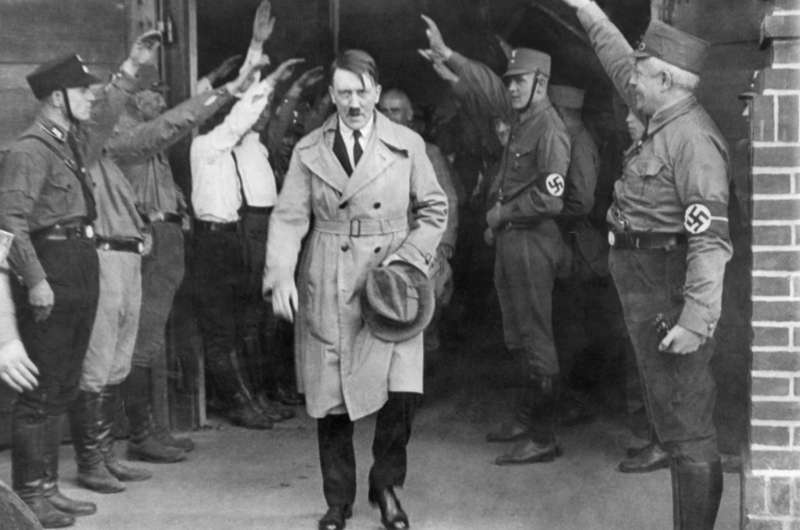
Adolf Hitler taking’s walking tour of historic Vienna
Now for a look at the darker times of Vienna. It’s the part of history that should not be forgotten. Discover the streets on which a young Hitler walked during this walking tour of historic Vienna. As you explore Vienna’s ornate Old Town, learn about Adolf Hitler’s early life and visit Jewish architecture that survived the Holocaust. You will see the only synagogue that survived WWII, war memorials, and more. See the devastation caused by more than 100,000 WWII bombs and pay your respects to monuments dedicated to lives lost.
The tour is around 2 and a half hours and teaches you about Hitler and his upbringing, and the impact he had on Vienna and the Jewish community. Embarking on this unusual yet powerful tour is perfect for history lovers and those wanting to delve deeper into Vienna’s past.
- Hitler Walking Tour, Albertinaplatz 1, next to Albertina Museum, behind the opera and opposite the tourist information.
- Tours are available every Monday, Thursday, and Saturday at 2:30 pm
- Tickets cost €28
4. Fake Art at the Fälschermuseum
The Fälschermuseum, or Museum of Art Fakes, is directly across from the Hundertwasserhaus. This “criminal” art museum is unique in Europe and probably worldwide. It is filled with fake paintings and mystery stories. Thieves always have interesting stories up their sleeves.
For example, one English master forger hid “time bombs” in his paintings. Eric Hebborn found eternal peace in a very, very suspicious way right after his book “The Art Forger's Handbook” was published. They found him lying in the street with head trauma. Dutch artist Han van Meegeren cheated German Hermann Göring into buying fake paintings during World War II, an act that made him a national hero. I really liked the impressive collection of fake art, which is sometimes more interesting than the originals of famous artists because of its story.
Even "faked" fake paintings exist! This isn’t just for art lovers; this is for lovers of compelling stories and amazing plot twists.
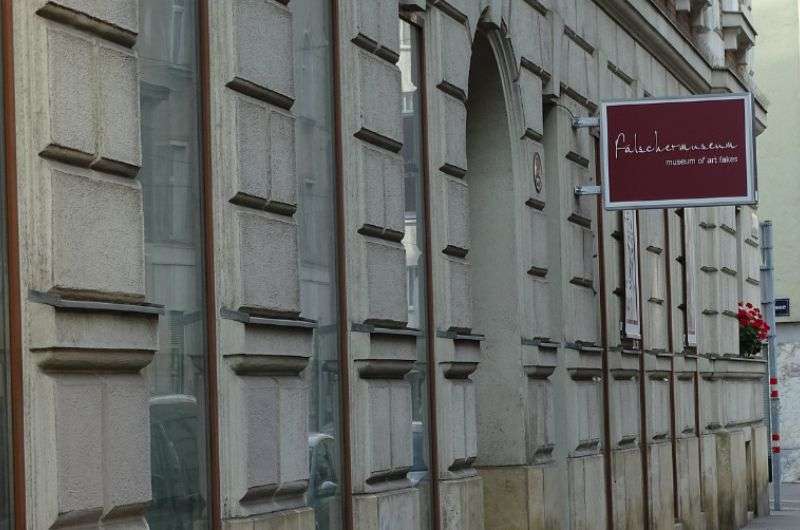
Fake Art at the Fälschermuseum—Fake it till you make it
Pro tip: This may be a quirky thing to do, but it’s also one of the best things to do in Vienna, as proven by the crowds trying to get in. Buy your tickets online in advance to avoid disappointment.
- Museum of Art Fakes, Löwengasse 28 (via the Hundertwasserhaus), a bit of City Center
- Open Tuesday to Thursday 10 am–4 pm, Friday to Sunday 10 am–5 pm, closed on Mondays
- Tickets cost €8.50
- But be aware it is one of the more popular tourist destinations in Vienna

5. The colorful architecture of Hundertwasser
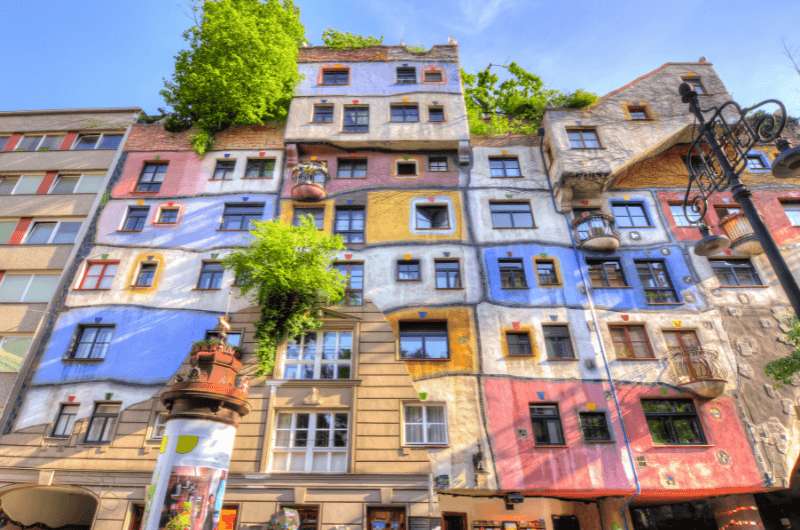
The colorful Hundertwasserhaus
It looks like you let kindergarten kids paint the façade, but in fact, it’s an architectural highlight, built in 1983–1985. Hundertwasserhaus is an apartment building designed by Friedensreich Hundertwasser, a famed Austrian painter. He was given complete free reign in the design of the house, and his style was loud and clear. You will see bold colors, swirling designs, and grass and trees everywhere.
The building is still used as a residence, so you can only look at it from the outside, but it’s still worth it.
-
Hundertwasser House, Kegelgasse 37–39
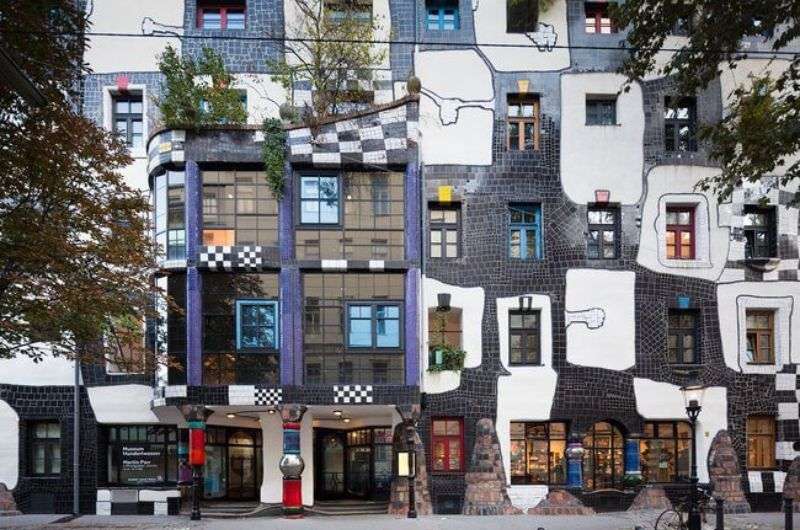
Kunst Haus Wien
For a deeper dive into Friedensreich Hundertwasser’s psyche, you can visit the awesome and similarly quirky Kunst Haus Wien. This building was also designed by the famed Austrian artist and has a colorful, irregular, tiled façade.
Inside, you can not only admire some top international exhibitions with a focus on photography. It also serves as the Hundertwasser Museum, which houses a comprehensive permanent exhibition of the artist’s works.
But don’t forget to look at the building itself, you can see touches of Hunderwasser’s ideas on ecology, nature, and sustainability everywhere. Stick around at the café downstairs for more artsy vibes.
- Kunst Haus Wien, Untere Weissgerberstrasse 13
- Kunst Haus Wien is currently closed until early 2024
6. Meet the famous stallions at the Spanish Riding School
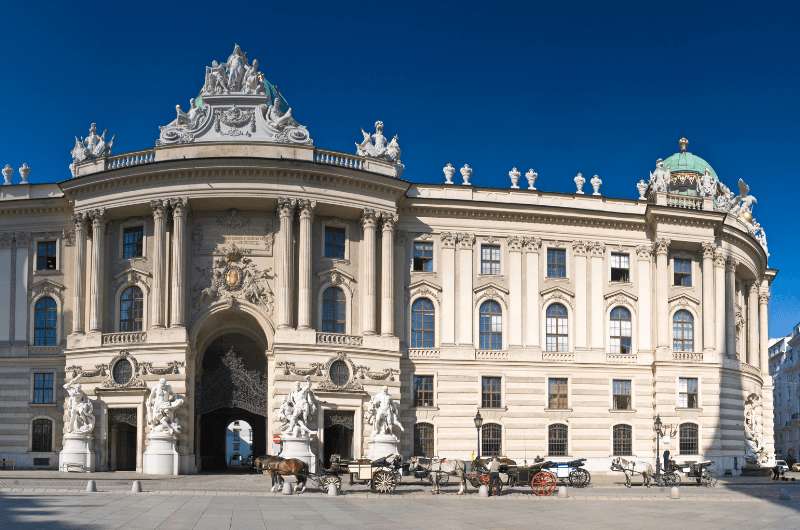
Spanish Riding School is the oldest classical horse-riding school in the world
Spanish Riding School is home to the Lipizzaner stallions, a uniquely beautiful and docile European horse breed. Forming part of the UNESCO Ranking of Immaterial Cultural Heritage, the Spanische Hofreitschule ranks in Austria’s List of National Cultural Assets.
Since it is the oldest classical horse-riding school in the world, the place is packed with history—in fact, the school was first mentioned in writing in 1565, during the reign of Archduke Maximilian II.
At the Riding School’s almost daily morning exercises (10 am—11 am), the public can observe the white baroque horses practice to beautiful classical music. They take place in the 18th-century baroque winter riding hall. Living in the Stallburg right in the city center, the 72 Lipizzaner stallions train next to the winter riding hall where they perform.
Fun fact: I’m allergic to horses, so, no, I haven’t visited the Lipizzaners myself, because sneezing and breaking out in hives isn’t something I’d call a cherished travel memory... though I guess it could be considered a very unique experience in Vienna. Memorable for sure.
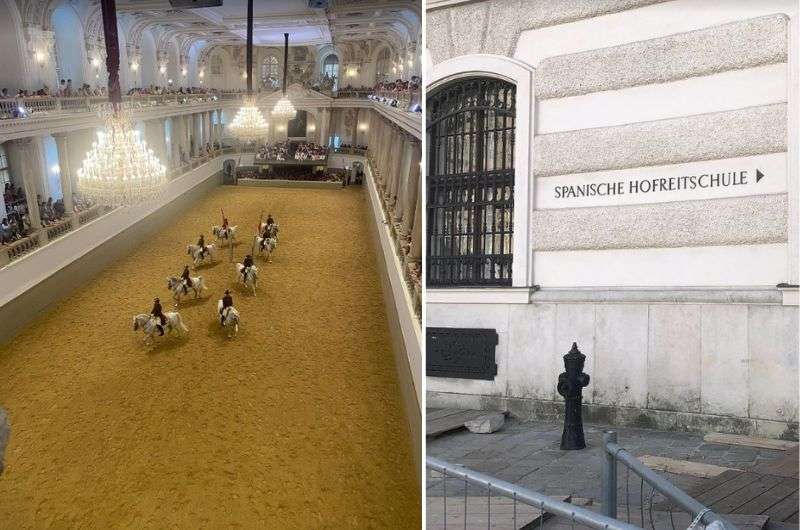
Something for horse lovers @ Spanische Hofreitschule
There are events that the public can visit, like Lipizzaner performances, and a guided tour of the school, too. Check the website for dates and times.
- Spanische Hofreitschule, Michaelerplatz 1, entrance is through Josefsplatz
- The visitor center is open Tuesdays to Sundays 9 am–4 pm; dates and times of performances vary
- Tickets start at €17 for morning exercises and €24 for the guided tour
Tip: If you are a horse fan, check out the riding school in Ronda, Spain. The Real Maestranza de Caballería in Ronda is one of the oldest and most prestigious in the world.
7. Check out the butterflies at Das Schmetterlingshaus
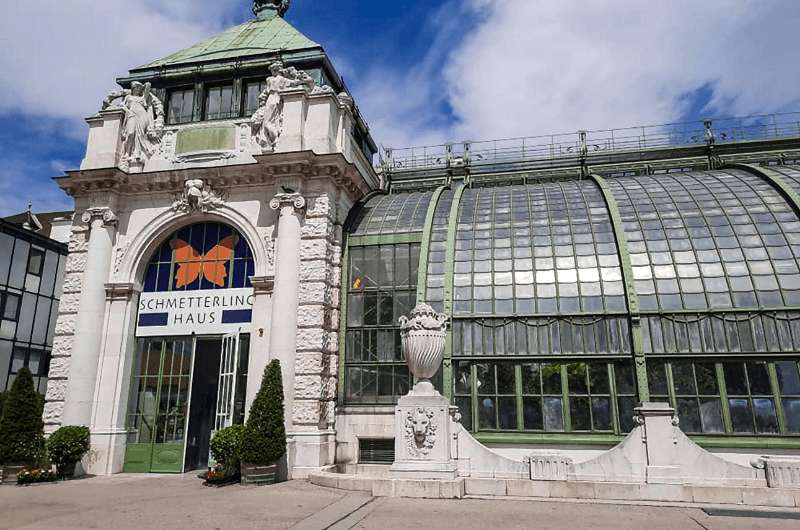
Das Schmetterlingshaus is a house of butterflies!
Welcome to the jungle! They say it’s more like a tropical oasis, but I’d say it’s closer to a damn jungle. You will walk through a small park and then enter the beautiful Art Noveau building. Prepare to be amazed.
The temperature and humidity will almost knock you down. After you come back to your senses, you are free to walk around and admire the approximately 400 big, free-flying butterflies. Even for someone who’s not a huge fan of these insects, the experience is still spectacular.
You can watch hundreds of butterflies flying around in an artificially created rainforest atmosphere and simply enjoy the peace and beauty of this experience. Surrounded by waterfalls, small ponds, and bridges, you will find a great sight, where you can also find information about the butterflies on the display boards. A special highlight is definitely the huge Atlas Butterfly, with its enchanting coloring and a maximum wingspan of up to 30 cm!
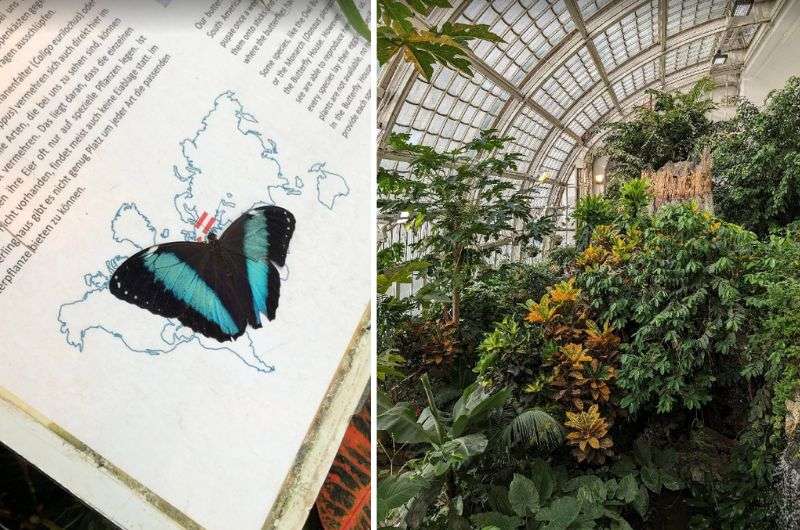
Welcome to the jungle! A rainforest atmosphere in the middle of the city @ Das Schmetterlingshaus
- Das Schmetterlingshaus, Hofburg Royal Palace, situated in the Burggarten, a couple of minutes from the Opera House (the nearest parking areas are Am Museumsquartier or Operngarage)
- Open daily from April to October 10 am–5:45 pm, November to March daily 10 am to 3:45 pm
- Tickets cost €10
8. Anatomical wax models at the Josephinum
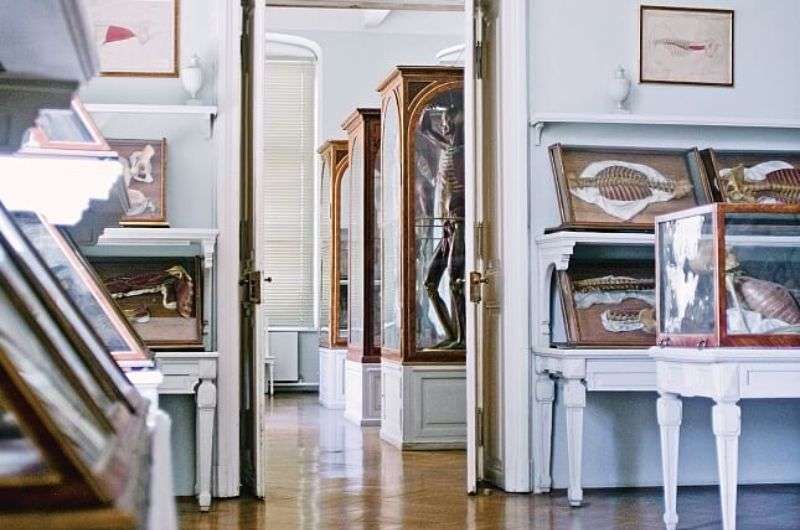
Check some anatomical wax models in Josephinum
Do you want one more tip for dark tourism? Many of these places have death associations. But in their own strange way, they embody the ‘beautiful death’ the Viennese aimed for. The others showcase the science, literature, and engineering of the Habsburg Empire.
One of them is Josephinum—the recently renovated Medical Museum with anatomical wax models. For me, the Josephinum is one of the many unique attractions in Vienna, Austria. The highlight is its large collection of 200-year-old anatomical and obstetric models made of wax: while designed as visual aids for teaching, they were also intended for public viewing and to this day are exhibited in their original display cases, made of rosewood and Venetian glass.
Three rooms of this earnest gore can occasionally make you feel like you’ve wandered onto the set of a horror movie or some hitherto unexplored part of your psyche. If you are confident and can hold down your breakfast, don't forget to save enough time to also see the large collection of medical instruments— “everything from tourniquets to cystoscopes”, the website promises—death masks and an oddly compelling collection of oil paintings, watercolors and photographs depicting operations and medical conditions.
Hey, you asked for quirky things to do in Vienna—don’t shoot the messenger!
- Josephinum, Währinger Straße 25
- Open Thursdays 10 am–8 pm and Wednesdays, Fridays, and Saturday 10 am–6 pm
- Tickets cost €15
9. A former psychiatric asylum: The Narrenturm
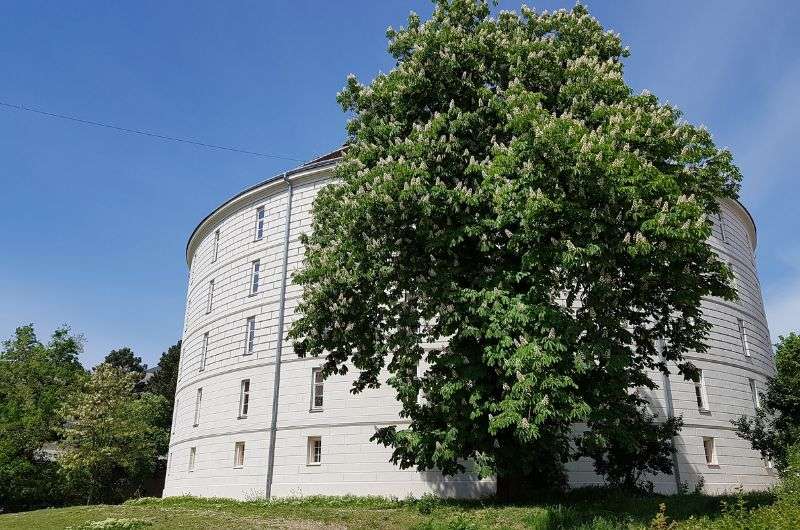
The Narrenturm, aka Fool’s Tower
If you thought my previous tip was “interesting”, well look out, because this next thing to do in Vienna is a little weird too: The Pathological-anatomical collection in the Narrenturm, known simply as The Narrenturm (or Fool’s Tower), is an old psychiatric hospital that closed in 1869. It was one of the first insane asylums ever built. Today, the Narrenturm no longer holds mentally imbalanced Viennese, but it does contain something else of interest.
In 1971, it reopened as an anatomical museum and has one of the world’s largest pathological collections. The museum has over 50,000 objects on display, from skeletons to furniture to preserved species. Just be warned, some of the things displayed are quite shocking. Syphilitic skulls that resemble Swiss cheese, jars of disfigured fetuses, and graphic wax displays of untreated STDs all peer out at you from the old cells.
It also contains a recreated wonder cabinet, complete with a narwhal tusk and taxidermized monkeys. Have fun!
- The Narrenturm, Spitalgasse 2
- Open Wednesday to Saturday 10 am–5 pm, closed Monday to Tuesday
- Tickets cost €8, guided tour is €4 extra

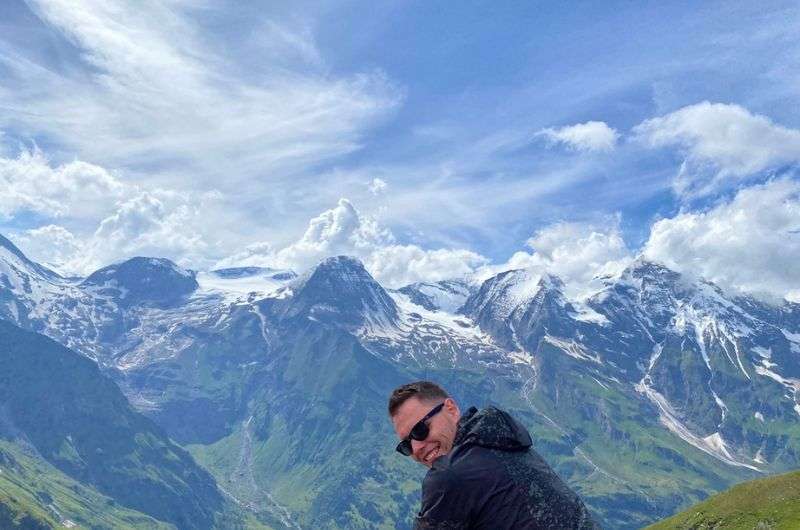
Which will win out for you, the beauty of the Austrian mountains or the historical secrets of Vienna?
What should you not miss in Vienna?
If you’re putting together your Vienna bucket list, don’t just stick to the usual palace-and-museum routine. Sure, check out Schönbrunn Palace and the Vienna State Opera, but if you want something truly memorable, climb up to Stephansdom’s roof for the best (and most underrated) views of the city, watch the Lipizzaner stallions train at the Spanish Riding School, walk through the macabre Narrenturm to see bizarre medical oddities, devour an original Sachertorte at Café Sacher because no, not all chocolate cakes are created equal, and get lost in the Fälschermuseum, where even the fake paintings have fake versions.
What is unique to Vienna?
Vienna prides itself on many things, but some experiences you won’t find anywhere else. The Spanish Riding School lets you watch the legendary Lipizzaner stallions perform their impressive dressage, Sachertorte from its birthplace is a must because any other version is just an imposter, Kunst Haus Wien is Friedensreich Hundertwasser’s architectural masterpiece that looks like it belongs in an acid trip, and Vienna’s underground catacombs allow you to walk among the remains of 11,000 people beneath Stephansdom. So, while Vienna isn’t exactly exciting, it does have its fair share of weird, fascinating, and one-of-a-kind experiences.
Is 3 days in Vienna too much?
Three days in Vienna is just right if you’re willing to put in the effort to find the good stuff. While I don’t think Vienna is the most exciting city to visit in Europe, 3 days is just enough time to uncover its quirky side. If you’re hopping from one palace to the next, then yes, three days might feel like an eternity. But if you mix in some of Vienna’s more unusual spots, dark tourism sites, and hidden gems, you might just enjoy yourself. Check out my 3-day Vienna itinerary to make the most of your visit.
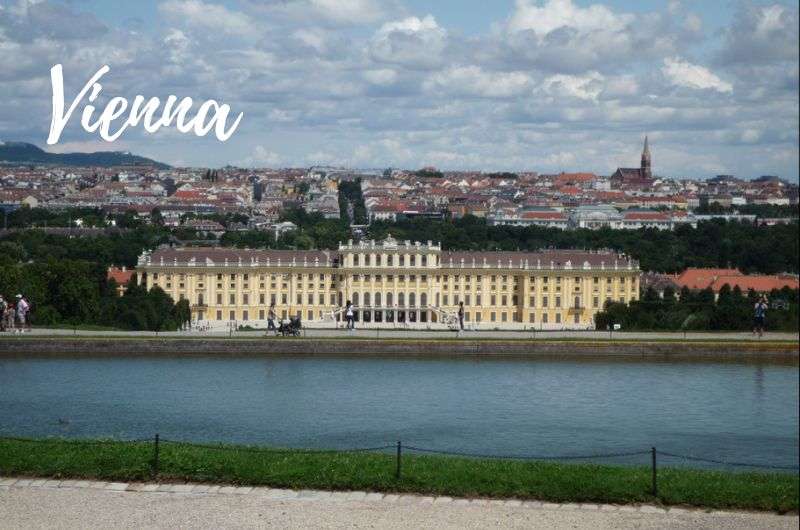
Is Vienna the most exciting city in Europe? Debatable. But if you know where to look (hint: rooftops, underground catacombs, and surreal art houses), it might just surprise you @ Schönbrunn
You might also be interested in reading:
- A Detailed 10-Day Austria Itinerary
- 3 Days in Vienna: The Ultimate Itinerary
- What is Austria Known For? 13 Tips and Tricks for Your Vacation
- 7 Top Tourist Cities in Austria: Highlights, Trips, Hotels, and More
This post contains affiliate links. I earn a small commission if you make bookings through my links, at no additional cost to you. Thank you for your support!


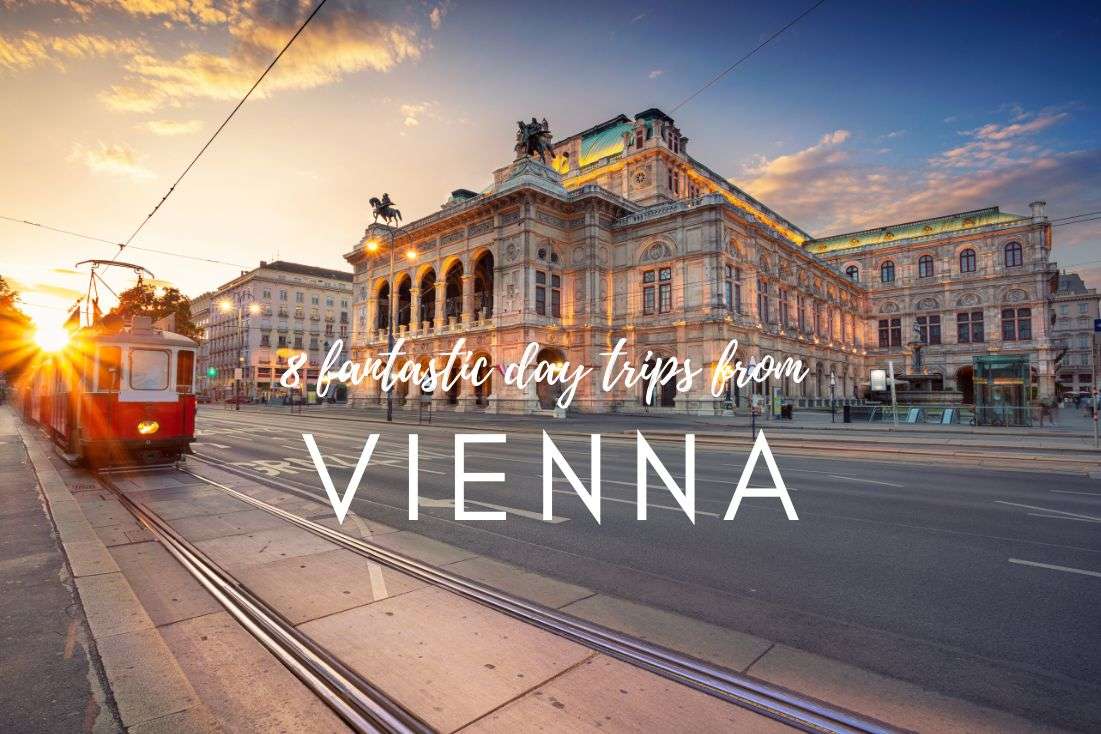

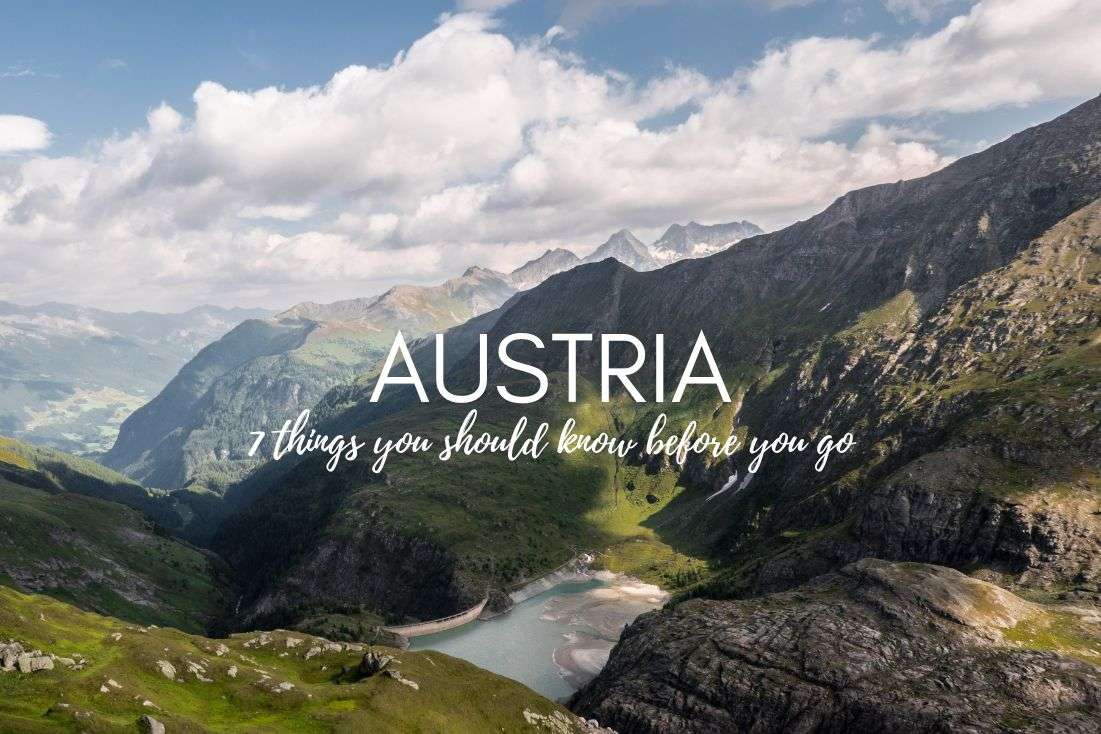
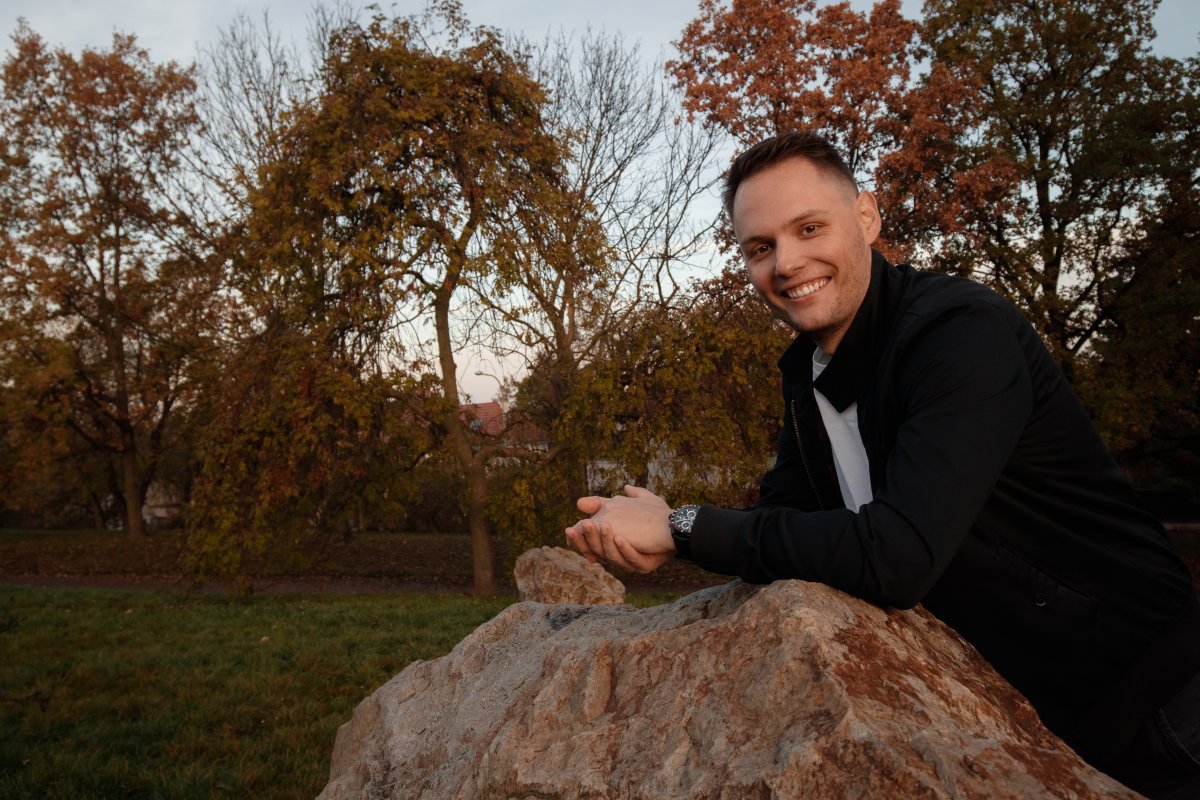




Comments | Thoughts? Give us a shout!